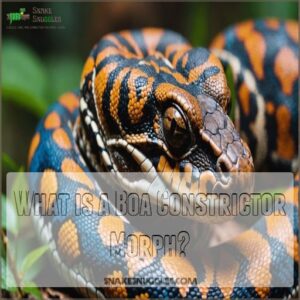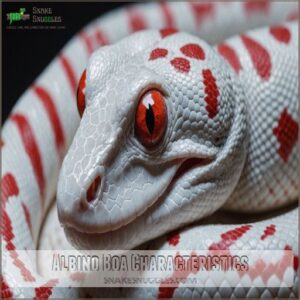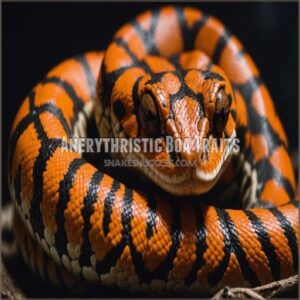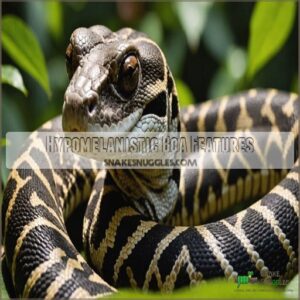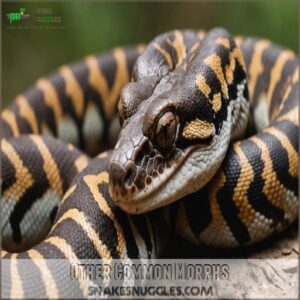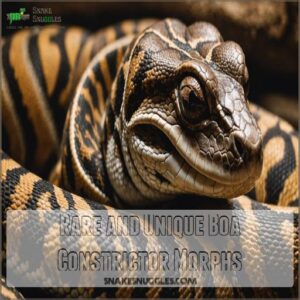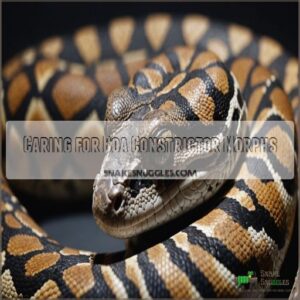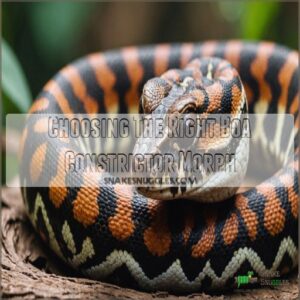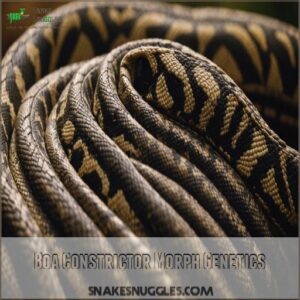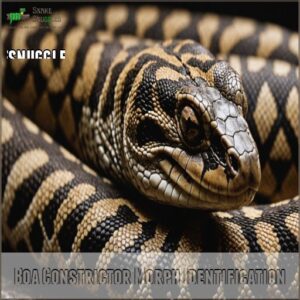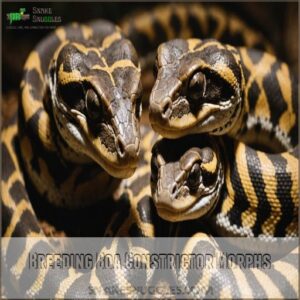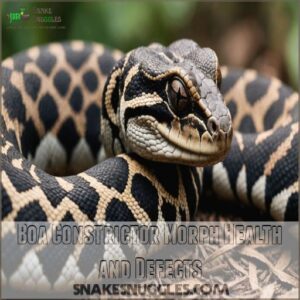This site is supported by our readers. We may earn a commission, at no cost to you, if you purchase through links.
 Understanding boa constrictor morphs is like discovering a genetic treasure trove.
Understanding boa constrictor morphs is like discovering a genetic treasure trove.
These morphs, far from being defects, are natural mutations that give your snake its cool looks.
The Albino, Anerythristic, and Hypomelanistic variants stand out with their unique colors, driven by dominant or recessive genes.
Each morph is like a hidden gem, waiting to be discovered.
Just remember, caring for these beauties means understanding their unique needs, from habitat to diet.
And if you’re ready, there’s much more about their intricacies that’s not just skin deep – but in their very DNA.
Ready to explore further?
Table Of Contents
- Key Takeaways
- What is a Boa Constrictor Morph?
- Common Boa Constrictor Morphs
- Rare and Unique Boa Constrictor Morphs
- Caring for Boa Constrictor Morphs
- Choosing The Right Boa Constrictor Morph
- Boa Constrictor Morph Genetics
- Boa Constrictor Morph Identification
- Breeding Boa Constrictor Morphs
- Boa Constrictor Morph Health and Defects
- Boa Constrictor Morph Market and Prices
- Frequently Asked Questions (FAQs)
- Are Boa constrictor morphs?
- What is a boa morph?
- What is a boa constrictor?
- Are boa constrictors good pets?
- What is the calmest boa constrictor?
- What is the best setup for a boa constrictor?
- What is the most docile boa constrictor?
- What are the dominant morphs in boas?
- How do environmental factors affect boa morphs?
- What is the lifespan of boa constrictor morphs?
- Can boa morphs interbreed with other snake species?
- How do boa morphs impact natural snake behavior?
- What are ethical concerns in breeding boa morphs?
- Conclusion
Key Takeaways
- You’ll discover that boa constrictor morphs result from genetic variations, creating unique patterns and colors without altering the species.
- Understanding the importance of recessive and dominant genes is crucial for breeding, impacting the morphs and their inheritance.
- To keep your boa constrictor healthy, focus on proper care with the right humidity, temperature, and diet tailored to its morph’s needs.
- Ethical breeding ensures your boa’s health, so prioritize genetic testing and responsible practices to avoid defects and promote wellness.
What is a Boa Constrictor Morph?
You’ve probably seen a rainbow boa, but did you know there’s a whole spectrum of boa constrictor colors?
A boa constrictor morph is a genetic mutation that changes the snake’s appearance, creating unique patterns and colors, similar to other reptile species where such mutations can result in various physical traits, like the popular ball python morphs. A boa constrictor morph is a genetic mutation that changes the snake’s appearance, creating unique patterns and colors that’ll make you do a double-take at the pet store.
Definition and Genetics
Ever wondered what makes some boa constrictors look like nature’s living art?
Boa constrictor morphs are genetic mutations that shake up a snake’s appearance without changing its species.
These DNA twists affect pigment production, creating stunning variants that’ll make your jaw drop.
Here’s what you need to know:
- Morphs aren’t birth defects, but natural variations
- They’re passed down through snake sex cells
- Genetic testing can reveal hidden morph potential
You’re not just looking at a pretty face – each morph tells a unique genetic story!
Dominant and Recessive Genes
You’ve got the basics of boa morphs down, now let’s talk genes.
Dominant and recessive genes are the puppet masters behind those stunning snake morphs.
Dominant genes are like the life of the party – they’ll show up even if there’s just one copy.
To understand how these genes interact, consider the role of Punnett squares in predicting genetic outcomes and breeding possibilities.
Recessive genes? They’re the wallflowers, only making an appearance when there are two copies.
It’s like a genetic dance-off in your boa’s DNA!
Inheritance Patterns
Delving into boa constrictor inheritance patterns is like unraveling a genetic puzzle.
You’ll encounter gene combinations that determine your snake’s unique look.
Recessive traits need two copies to show up, while co-dominant genes share the spotlight.
Mutation impact can be a wild card, shaking up breeding predictions.
As you get into snake breeding, remember: captive bred snakes often showcase these fascinating inheritance patterns in living color.
Common Boa Constrictor Morphs
You’re about to enter a world where boa constrictors come in more flavors than your local ice cream shop.
From the striking albinos to the mesmerizing hypomelanistics, you’ll discover why these common morphs are anything but ordinary.
Albino Boa Characteristics
Albino boas are real show-stoppers in the reptile world.
You’ll spot these beauties by their lack of melanin, resulting in a striking white or cream body with ruby-red eyes.
They’re not just pretty faces; their temperament is typically docile, making them great for handling.
In terms of albino boa care, they’re sensitive to light, so you’ll need to provide UV-free environments.
Their unique genetics can fetch a higher price, but trust me, these pink panthers are worth every penny.
Anerythristic Boa Traits
Shifting gears from the eye-catching albinos, let’s explore the mesmerizing world of Anerythristic boas.
These striking snakes lack red pigment, resulting in a stunning silver body with a lavender tail that morphs into brown and yellow as they age.
Anerythristic boa breeding can be tricky, but the payoff is worth it.
Their unique pattern and coloration make them highly valued in the reptile community.
With proper Anerythristic boa care, you’ll have a showstopper on your hands!
Hypomelanistic Boa Features
Now, let’s turn our attention to the hypomelanistic boa, a true showstopper in boa morphs.
These beauties sport reduced brown and black pigmentation, resulting in a vibrant, eye-catching appearance.
You’ll find two main lines: salmon and orangetail, each with its own unique flair.
Here’s what makes hypos stand out:
- Radiant, sun-kissed scales that seem to glow
- Crisp, clear patterns that pop against their lighter background
- Striking contrast between their vivid body colors and subtle dark accents
- Mesmerizing transformation as they mature, often intensifying in color
Other Common Morphs
Let’s explore a world of other common boa morphs!
Similar to ball python morphs, which boast thousands of different morphs due to remarkable genetic diversity through selective breeding exploring ball python genetics. You’ll find a treasure trove of stunning color variations and unique genetic traits.
Check out this quick guide to some fan favorites:
| Morph | Key Features | Care Tip |
|---|---|---|
| Motley | Striped pattern | Keep humidity high |
| Jungle | Reduced pattern | Monitor shedding |
| Sunglow | Vibrant orange | UV light beneficial |
| Moonglow | Pale, ghostly hue | Gentle handling |
Remember, each morph’s care requirements may vary slightly, so always do your homework before bringing one home!
Rare and Unique Boa Constrictor Morphs
You’re about to discover some of the rarest and most unique boa constrictor morphs that’ll make your jaw drop.
From the mesmerizing patterns of the Leopard Boa to the ethereal beauty of the Snow Boa, these genetic wonders are like winning the snake lottery – rare, valuable, and absolutely stunning.
Leopard Boa Characteristics
While you might think you’ve seen it all, the Leopard Boa will make your jaw drop.
This rare beauty boasts spots that’d make any big cat jealous.
Here’s what makes them stand out:
- Intricate leopard-like patterns covering their entire body
- Calm temperament, perfect for handling
- Higher price tag due to their rarity
You’ll need deep pockets for this showstopper, but their unique looks and easygoing nature make them worth every penny.
Just be prepared for a wild hunt to find one!
Snow Boa Traits
A jaw-dropping sight awaits you with the Snow boa, a rare gem in the boa constrictor world. This arctic beauty combines albino and anery traits, resulting in a stunning white or pale yellow snake with ruby-red eyes. You’ll find their temperament as cool as their looks, making them a breeze to handle.
| Trait | Description | Notes |
|---|---|---|
| Color Variation | White to pale yellow | Stunning contrast |
| Temperament | Docile and calm | Easy to handle |
| Care Needs | Standard boa care | Sensitive to UV light |
Breeding Snow boas can be tricky, but the payoff is worth it. Their price range reflects their rarity, so be prepared to shell out some serious cash for these frosty friends.
Ghost Boa Features
As you explore the world of ghost boas, you’ll uncover a morph that’s truly out of this world. These ethereal serpents boast a unique combination of genes that’ll make your jaw drop:
- Muted, smoky appearance that’s hauntingly beautiful
- Subtle pattern that seems to fade in and out like a specter
- Temperament as calm as a misty morning
- Price tag that might give your wallet a ghostly chill
Ghost boas are the result of some clever breeding tricks, combining hypo and anery genes for a stunning, otherworldly look.
Other Rare Morphs
Ghost boas are just the tip of the iceberg when it comes to rare morphs.
You’ll find jaw-dropping varieties like the Moonglow, with its ethereal white hue, or the Sunset, flaunting vibrant orange and red tones.
These rarities often come with a hefty price tag, but for many enthusiasts, they’re worth every penny.
Identifying these unique morphs can be tricky, so consult experts or genetic testing for certainty.
Caring for Boa Constrictor Morphs
You’ll find that caring for boa constrictor morphs requires understanding their specific needs, such as maintaining a temperature gradient, as explained in the boa constrictor for beginners, isn’t rocket science, but it does require some snake-savvy know-how.
From creating the perfect humid hideaway to nailing their temperature sweet spot, you’re about to become a pro at keeping your slithery friend happy and healthy.
Environmental Influences on Morphs
Your boa’s environment plays a huge role in its appearance.
Temperature fluctuations can affect skin health and color vibrancy.
Proper lighting is key – it’s like giving your snake a natural sun lamp!
To make sure you’re providing the best environment, consider investing in high-quality products specifically designed for boa constrictor morph care, such as those found at boa constrictor morph products.
Stress can dull those stunning patterns, so keep things calm.
And don’t forget nutrition – a well-fed boa is a showstopper.
It’s like caring for a living rainbow; get it right, and you’ll be rewarded with a dazzling display!
Housing and Humidity Requirements
Creating the perfect home for your boa constrictor morph is like building a cozy retreat. Here’s your game plan:
- Spacious enclosure: Think penthouse suite, not cramped studio
- Comfy substrate: Cypress mulch or coconut husk for burrowing bliss
- Proper ventilation: Fresh air without the draft
- Humidity haven: Large water bowl and misting system for that tropical vibe
Remember, a happy boa is a healthy boa. Keep their home clean and you’ll have a content, colorful companion.
Temperature and Lighting Needs
A boa constrictor’s comfort relies on maintaining ideal temperatures.
Use heat mats and thermostats for precise warmth, creating cozy basking spots.
Introduce UVB lighting to mimic seasonal changes and maintain their circadian rhythms.
Balancing light and warmth enhances their vibrant colors and stress-free environment.
It’s like tailoring a perfect suit for your fashion-forward snake!
Diet and Nutrition
To keep your boa constrictor morph thriving like a true champion, it’s essential you nail its diet.
A boa constrictor’s natural diet consists of varied prey items, including birds, lizards, and small mammals.
Here’s the scoop:
- Feeding Frequency: Feed juveniles weekly and adults bi-weekly.
- Prey Size: Match prey size to your snake’s width.
- Supplements: Occasionally, add vitamins to guarantee all nutritional needs are met.
Remember, dietary variations are key to health!
Choosing The Right Boa Constrictor Morph
Selecting the perfect boa constrictor morph might feel like picking a star in the snake universe, but with the right research on breeders and understanding morph prices, you’ll find a match as rare as a comic book first edition.
Just remember to factor in each morph’s temperament and care needs while preparing for their lifelong companionship, or you might end up with a more thrilling tale than anticipated!
Researching Reputable Breeders
Knowing reliable breeders is essential when choosing the right boa constrictor morph.
Look for health guarantees, ask about genetic testing, and make sure transparency.
Breeding ethics matter, as does the welfare of these amazing creatures.
| Feature | Good Breeder | Warning Signs |
|---|---|---|
| Health Guarantees | Offered | None Provided |
| Genetic Testing | Available | Unavailable |
| Breeder Transparency | Open Communication | Evasive Answers |
Understanding Morph Prices
Finding a dedicated boa breeder? You’re not alone!
Now, let’s tackle morph prices. Consider these:
- Morph rarity—rarer morphs drive up costs.
- Price factors—breeding ethics impact value.
- Market trends—today’s trends shape tomorrow’s prices.
Keep your heart in check, even if your wallet’s itching.
Remember, it’s not just snakes; it’s investments!
Considering Temperament and Care
Curiosity might lead you to a colorful boa, but temperament and housing needs should seal the deal.
Reflect on enclosure size and care requirements; they’re your boa’s home sweet home.
Each morph may have its quirks, from diet to demeanor.
| Temperament | Housing Needs | Care Requirements |
|---|---|---|
| Gentle | Spacious | Regular Handling |
| Spirited | Secure Lid | Temperature Monitoring |
| Docile | Climbing Areas | Humidity Control |
| Independent | Hide Spaces | Morph-Specific Diets |
| Curious | Ventilated | Social Interaction |
Preparing for Life Expectancy
Someone once said, "owning a boa is marathon, not a sprint!"
Before you jump in, consider your boa morph lifespan.
Different morphs have varying health concerns, impacting their longevity.
Captive-bred boas, for instance, tend to be more docile and healthier than wild-caught boas, as discussed in [boa constrictor care guide](https://snakesnuggles.com/boa-constrictor-care-guide/#:~:text=Boa Constrictor Species and Temperament. Choosing your boa constrictor is).
To prepare, you’ll need:
- Regular vet care.
- Understanding of breeding impact on lifespan.
- Ethical considerations regarding responsible ownership.
These factors, alongside your lifestyle, will help you choose wisely!
Boa Constrictor Morph Genetics
Understanding boa constrictor morph genetics can feel like sorting through a colorful family tree, but it reveals how fascinating mutations manifest in snakes.
With a few hustle-and-bustle genes, these boas turn into stunning variations, making each snake a unique work of art.
Genetic Mutations and Expression
Selecting your boa morph connects seamlessly to understanding genetic mutations and expression.
Specific mutations lead to the vibrant hues and patterns you adore.
Ethical breeding guarantees these traits are responsibly passed on.
Consider genetic testing to understand this colorful puzzle, revealing how morph inheritance and gene interactions shape your boa.
It’s like solving a magnificent, scaly mystery!
Inheritance Patterns and Predictions
You’ve mastered morph genetics, now let’s tackle inheritance patterns.
Imagine morph combinations like a family quilt, stitching genes together.
For those looking to acquire specific morphs, consulting with reputable boa constrictor morph breeders online morph breeders can be a great starting point.
Breeding strategies can shift color prediction from dream to reality.
Genetic testing acts as a crystal ball, minimizing genetic risks.
By fine-tuning these elements, you can predict your boa’s future hues with confidence, making you the maestro of your morph marvels.
Boa Constrictor Morph Identification
Spotting the unique patterns and colors of boa constrictor morphs can feel like a thrilling game of nature’s "Where’s Waldo," but don’t worry, there’s method to the madness.
You’ll find combining visual cues with genetic testing helps accurately identify these stunning variations, guiding you through the fascinating world of rare and common morphs alike.
Visual Identification Techniques
Spotting boa morphs might feel like deciphering a complex puzzle, but don’t fret—visual cues are your best friends.
Begin with color patterns and search for unique pattern variations.
Morph comparisons help highlight key features.
It’s like finding the perfect puzzle piece that fits.
Just remember: each boa boasts its own exceptional design worth admiring!
Genetic Testing and Verification
Understanding a boa’s morph isn’t just skin deep.
Genetic testing brings precision, supplementing visual cues with DNA profiling.
You might face costs, but it’s worth verifying morph accuracy.
Consider these when opting for testing:
- Accuracy concerns: Verify the lab’s reliability.
- Ethical considerations: Respect snake welfare.
- Genetic databases: Cross-reference for validation.
Identifying Rare and Unique Morphs
How can you confidently identify those elusive rare boa morphs?
Mastering morph identification tips is key!
Visual cues are your first clue, but genetic testing offers definitive proof.
Breeding for rarity requires patience.
| Morph | Visual Cues | Morph Value |
|---|---|---|
| Leopard | Distinct spots, high contrast | Very High |
| Snow | Reduced pigmentation, pastel colors | High |
| Ghost | Pale, muted coloration | High |
| Calico | Patchwork of colors | Medium-High |
| Albino Het Hypo | Subtle color variations, potential for albinism | Medium |
Remember, even experts sometimes need genetic testing for confirmation.
Breeding Boa Constrictor Morphs
Breeding boa constrictor morphs requires a mix of art and science, where understanding genetics transforms you into a sort of reptile matchmaker.
Be prepared to master the intricacies of compatible pairs and gene combinations to create snakes that are as stunning as they’re healthy.
Breeding Strategies and Techniques
Imagine you’re a boa breeder, mixing art and science.
Line breeding enhances traits in morph combinations, but genetic diversity keeps your boas healthier.
Ethical breeding avoids overcrowding, ensuring each boa thrives.
Master incubation techniques to hatch vibrant morphs.
Remember, breeding’s more than mere chance—it’s crafting a legacy.
So, sprinkle love and expertise, and watch wonders unfold!
Selecting Compatible Morphs
Breeding strategies are just the tip of the iceberg.
When you select compatible morphs, it’s like piecing together a genetic puzzle.
Consider genetic compatibility and the health of your boas.
You’re aiming for desired offspring without sacrificing ethics.
Think of it as matchmaking for snakes—finding that perfect pair requires knowledge, patience, and a sprinkle of humor.
Avoiding Genetic Defects
Avoiding genetic defects in boa morphs isn’t just luck; it’s science!
Learn about genetics like a pro to keep your snakes healthy.
Here’s a bite-sized checklist:
- Genetic Testing: Use it to catch inbreeding risks early.
- Health Screening: Regular checks make sure your boas stay fit.
- Responsible Breeding: Ethical practices protect future generations.
Keep those snakey smiles bright!
Breeding for Rare Morphs
Swerving away from genetic mishaps, eyeing the glitter of rare morphs can feel like discovering treasures.
Ethical considerations and genetic testing are your trusty compass, steering you clear of breeding risks while maximizing profit margins.
Market demand keeps your hatchlings sought-after.
Think of it like crafting a masterpiece, where each scale paints a unique story of nature’s artistry and your careful planning.
Boa Constrictor Morph Health and Defects
When breeding boa constrictor morphs, you must watch out for genetic defects that can pop up like uninvited guests at a party.
Spotting and handling these potential health issues early helps your slithery friend lead a happy and healthy life.
Genetic Defects and Health Issues
Because you’re aiming for mastery in boa constrictor breeding, understanding genetic defects is essential.
Incompatible morphs increase breeding risks potentially leading to health complications.
Boa constrictor morph breeding also heavily relies on understanding recessive and dominant genes, as seen in [recessive and dominant genes](https://snakesnuggles.com/boa-constrictor-color-morphs/#:~:text=Popular Boa Constrictor Color Morphs. Among boa).
Genetic testing can help you avoid these pitfalls.
Common diseases, sadly, can crop up even with careful planning.
Remember, responsible breeding means prioritizing the snake’s well-being above all else.
It’s a balancing act, but one you can master!
Identifying and Managing Health Problems
Spot a sick boa? Keep an eagle eye on common health issues which can sneak up on your scaly friend. Genetic testing aids early detection, curtailing concerns before they snowball.
- Preventative care: Routine checks and a healthy diet work wonders.
- Treatment options: Consult a vet if illness arises.
- Husbandry errors: Make sure proper habitat conditions to avoid stress.
Preventing Birth Defects
To prevent birth defects in boa constrictor morphs, pay close attention to incubation temperatures and make sure genetic compatibility is met.
Practice responsible breeding and stick to ethical practices, keeping snake health a top priority.
Think of breeding as baking a cake; the right ingredients make all the difference. Just as you’d avoid expired eggs, choose healthy, compatible snakes for thriving offspring.
Common Health Issues in Morphs
Ever notice how boas sometimes have shedding problems or a few hiccups like respiratory infections?
Keeping an eye out for parasite infestations is key.
Be wary of metabolic bone disease and nutritional deficiencies—they can sneak up on you!
A balanced diet and proper care go a long way in preventing these health issues, ensuring your morph stays in tip-top shape.
Boa Constrictor Morph Market and Prices
When you’re exploring the boa constrictor morph market, expect a colorful adventure featuring price tags that can be as vibrant as the snakes themselves.
From affordable options to rare finds that might make your wallet feel a bit constricted, there’s something for every enthusiast.
Market Trends and Demand
After exploring health hiccups, let’s chat morph market trends.
Nowadays, certain boas are hotter than others.
Albino and Ghost morphs? They’re all the rage, fetching quite a price.
Breeders craft alluring combinations, sparking collector demand.
Watching pricing trends feels like a stock ticker.
Remember, ethical breeding and solid breeder networks keep this hobby thriving with fascinating morph popularity.
Finding Reputable Breeders and Sellers
Understanding morph market trends is fun, but finding reputable breeders and sellers? That’s where the rubber meets the road.
Breeding ethics and health guarantees are key. You want price transparency and ethical sourcing.
Customer reviews can be your best friend or your worst nightmare.
- Health Guarantees: Make sure your boa is healthy.
- Breeding Ethics: Trustworthy practices matter.
- Price Transparency: Know what you’re paying for.
Avoiding Scams and Misrepresentation
So, you’ve found a potential breeder.
Great!
Now, let’s be smart.
Scrutinize their claims, especially when it comes to unique boa colors, as these are often the result of genetic mutations that can heavily impact the snake’s appearance and value Understanding Boa Constrictor Morphs.
Do their prices align with market analysis?
Demand a health guarantee and proof of genetic testing; transparency is key.
Don’t fall for inflated prices or vague descriptions.
A reputable breeder will be open about their practices.
Remember, a healthy boa is priceless!
Frequently Asked Questions (FAQs)
Are Boa constrictor morphs?
Imagine boa constrictor morphs as a rainbow of fascinating genetic surprises.
They’re like boa fashionistas, flaunting unique colors and patterns due to genetic mutations.
Breeders adore them, creating exotic serpentine beauties just for the curious at heart.
What is a boa morph?
A boa morph is a stunning genetic mutation that changes your boa constrictor’s appearance without altering its breed.
These transformations result from DNA variations affecting pigment, creating unique colors and patterns.
These unique colors and patterns are passed down to baby snakes.
What is a boa constrictor?
You’ll find boa constrictors are non-venomous snakes, known for their impressive size and constricting abilities.
They’re fascinating creatures, inhabiting diverse habitats, and are popular among reptile enthusiasts.
They require specific care to thrive.
Are boa constrictors good pets?
A boa constrictor isn’t your average fluffy hamster; it offers a striking blend of beauty and challenge.
With proper care and respect, it makes a fascinating pet.
Make sure you’re ready for its housing, diet, and size.
What is the calmest boa constrictor?
If you crave a laid-back reptile companion, the Hypo Boa Constrictor often fits the bill.
Known for their gentle temperament, they’re less likely to be jittery or aggressive—giving you peace of mind and a rewarding friendship.
What is the best setup for a boa constrictor?
Creating a cozy, theater-style enclosure for your boa involves plenty of space, controlled humidity, and a temperature gradient.
Add hiding spots and branches.
Balance lighting to highlight their colors—a setup fit for a star on stage.
What is the most docile boa constrictor?
Boa constrictors, known for their generally calm demeanor, often show gentler behavior, especially in captive-bred forms.
The Colombian boa morph is particularly noted for its docility, making it popular among snake enthusiasts who want a laid-back pet.
What are the dominant morphs in boas?
Motley and Arabesque morphs dominate with their co-dominant genes, producing remarkable patterns even in one parent.
Motley offers a unique disrupted look, while Arabesque creates intense speckling.
Both add a dash of flair to any collection.
How do environmental factors affect boa morphs?
Imagine controlling nature itself!
Environmental factors like temperature, humidity, and lighting, similar to those found in the habitats of Kenyan sand boa morphs, can dramatically affect boa morph colors.
Think of these elements as artist tools, shaping their vibrant hues and ensuring their stunning appearances thrive beautifully.
What is the lifespan of boa constrictor morphs?
Generally, boa constrictors live 20-30 years. However, proper care is key! A healthy diet and stress-free environment greatly impact their lifespan. So, give them the royal treatment!
Can boa morphs interbreed with other snake species?
When pigs fly, you might see a boa morph interbreeding with different snake species.
It’s biologically impossible due to genetic differences.
Each snake has unique traits preventing successful cross-species breeding.
So, stick to your boa morph fantasy breeding!
How do boa morphs impact natural snake behavior?
Boa constrictor morphs don’t affect natural snake behavior much.
You’ve got the same instincts and temperament underneath those colorful skins.
Morphs primarily alter appearance, leaving the snake’s core behaviors, like hunting and basking, mostly untouched and predictable.
What are ethical concerns in breeding boa morphs?
In your quest to breed boa morphs, you’ll face ethical dilemmas like avoiding harmful genetic combinations and ensuring healthy living conditions.
Responsible breeding practices are paramount.
Prioritize choosing compatible morphs and maintaining transparency to prevent potential health issues.
Conclusion
Imagine this: you’ve just stumbled upon a vibrant world of boa constrictor morphs, each a masterpiece of nature’s artistry.
Now that you’re equipped with this boa constrictor morph guide, you’re ready to explore and care for these intriguing creatures.
Remember, from vibrant albinos to the elusive ghost boa, every morph is a unique puzzle piece in the boa family tapestry.
Whether you’re breeding or caring, make sure you’re prepared for this colorful journey ahead!

